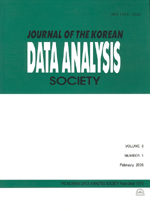확률 과정에 기반한 교통망 성능 지수
A Stochastic Approach to Traffic Network Performance Index
- 한국자료분석학회
- Journal of The Korean Data Analysis Society (JKDAS)
- Vol.13 No.1
-
2011.02207 - 219 (13 pages)
- 3

교통망의 성능은 주어진 네트워크 하에서 교통흐름이 얼마나 효율적인지를 나타내는 것으로, 교통망 운영 및 관리, 그리고 교통정책 수립에 매우 중요한 의사결정 지원수단이 된다. 교통현상의 확률적 규칙을 설명하기 위한 확률 과정으로서 대기행렬 이론은 이러한 교통 네트워크의 성능을 평가하는데 매우 유용하다. 이에 따라 본 연구에서는 우리나라 고속도로 교통망에 대한 최적의 대기행렬 모형을 이용하여, 확률과정 기반 교통망 지수를 제안한다. 교통망을 가장 잘 설명하는 모형을 찾기 위해 비선형 최적화 방법으로 구조변화를 갖는 대기행렬 모형을 구축하고, 그에 대한 Speed-Flow-Density 다이어그램으로 혼잡도 및 통행시간 관련 성능 지수를 개발하여 교통망의 요일별 시간별 성능을 평가하고자 한다.
Performance of road network indicates how much traffic flow is efficient, and it can be a very important decision-maker in network operation, management and transportation policy. A queueing theory, a stochastic process, to explain the stochastic phenomena of traffic, is very useful to assess the traffic network performance. This research propose the traffic network performance index based on the stochastic process, using the optimal queueing model for Korean expressway. We specify queueing model with structural change by nonlinear optimization method to find the optimal model for road network, and develop performance indexes in terms of congestion and travel time based on Speed-Flow-Density diagram. We valuate the network performance for each spot per day and time.
1. 서론
2. 구조변화를 갖는 확률 과정
3. 교통망 성능 지수
4. 실증 분석
5. 결론
참고문헌
(0)
(0)